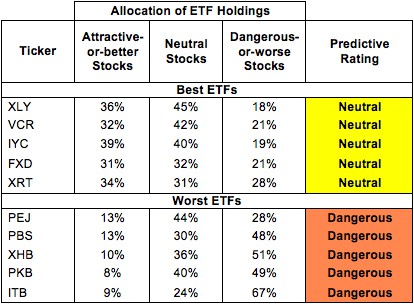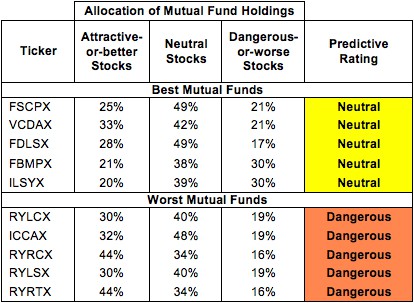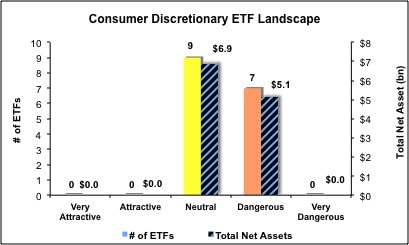The Consumer Discretionary sector ranks fifth out of the ten sectors as detailed in my Sector Rankings for ETFs and Mutual Funds report. It gets my Neutral rating, which is based on aggregation of ratings of 16 ETFs and 27 mutual funds in the Consumer Discretionary sector as of April 18, 2013. Prior reports on the best & worst ETFs and mutual funds in every sector and style are here.
Figures 1 and 2 show the five best and worst-rated ETFs and mutual funds in the sector. Not all Consumer Discretionary sector ETFs and mutual funds are created the same. The number of holdings varies widely (from 24 to 376), which creates drastically different investment implications and ratings. The best ETFs and mutual funds allocate more value to Attractive-or-better-rated stocks than the worst ETFs and mutual funds, which allocate too much value to Neutral-or-worse-rated stocks.
To identify the best and avoid the worst ETFs and mutual funds within the Consumer Discretionary sector, investors need a predictive rating based on (1) stocks ratings of the holdings and (2) the all-in expenses of each ETF and mutual fund. Investors need not rely on backward-looking ratings.
My fund rating methodology is detailed here.
Investors should not buy any Consumer Discretionary ETFs or mutual funds because none get an Attractive-or-better rating. If you must have exposure to this sector, you should buy a basket of Attractive-or-better rated stocks and avoid paying undeserved fund fees. Active management has a long history of not paying off.
Get my ratings on all ETFs and mutual funds in this sector on my free mutual fund and ETF screener.
Figure 1: ETFs with the Best & Worst Ratings – Top 5
* Best ETFs exclude ETFs with TNAs less than $100 million for inadequate liquidity.
Sources: New Constructs, LLC and company filings
Market Vectors Retail ETF (RTH), Guggenheim S&P Equal Weight Consumer Discretionary (RCD), and Direxion Daily Retail Bull 3x Shares (RETL) are excluded from Figure 1 because their total net assets (TNA) are below $100 million and do not meet our liquidity standards.
Figure 2: Mutual Funds with the Best & Worst Ratings – Top 5
* Best mutual funds exclude funds with TNAs less than $100 million for inadequate liquidity.
Sources: New Constructs, LLC and company filings
Fidelity Advisor Consumer Discretionary Fund (FCNIX, FCECX) and ICON Consumer Discretionary Fund (ICCCX) excluded from Figure 2 because their total net assets (TNA) are below $100 million and do not meet our liquidity standards.
Consumer Discretionary Select Sector SPDR (XLY) is my top-rated Consumer Discretionary ETF and Fidelity Select Portfolios: Consumer Discretionary Portfolio (FSCPX) is my top-rated Consumer Discretionary mutual fund. Both earn my Neutral rating.
iShares Dow Jones U.S. Home Construction Fund (ITB) is my worst-rated Consumer Discretionary ETF and Rydex Series Funds: Retailing Fund (RYRTX) is my worst-rated Consumer Discretionary mutual fund. Both earn my Dangerous rating.
Figure 3 shows that 110 out of the 446 stocks (over 26% of the market value) in Consumer Discretionary ETFs and mutual funds get an Attractive-or-better rating. However, no ETFs or mutual funds allocate enough value to Attractive-or-better rated stocks to get an Attractive rating.
The takeaways are: mutual fund managers allocate too much capital to low-quality stocks and Consumer Discretionary ETFs hold poor quality stocks.
I find it a bit appalling that despite all the high quality stocks in the sector there are no Attractive or better ETFs or mutual funds. Investors deserve better.
Figure 3: Consumer Discretionary Sector Landscape For ETFs, Mutual Funds & Stocks
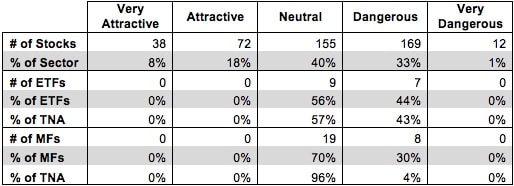
As detailed in “Cheap Funds Dupe Investors”, the fund industry offers many cheap funds but very few funds with high-quality stocks, or with what I call good portfolio management.
Investors should avoid Consumer Discretionary ETFs and mutual funds, as no ETFs or mutual funds in the Consumer Discretionary sector allocate earn an Attractive-or-better rating. Investors seeking exposure to this sector should buy a basket of Attractive-or-better rated stocks instead.
Coach Inc. (COH) is one of my favorite stocks held by Consumer Discretionary ETFs and mutual funds and earns my Very Attractive rating. The relatively low capital requirements of Coach’s luxury leather goods business means it can earn a very high return on invested capital (ROIC), nearly 50% last year. Coach has also shown an impressive ability to grow profitability over the years. After tax profit (NOPAT) has grown by 28% compounded annually for the past decade. (More on Coach’s management team and profit growth in this article.) However, the market appears to be cautious in its expectations for COH. At its current valuation of ~$50.85/share, COH has a price to economic book value of 1.1, implying only 10% growth in NOPAT over the rest of its corporate life. Given the 28% CAGR for the past decade, 10% is a low hurdle. COH is currently trading near its 12 month low. Now is a great time to snap up this highly profitable company at an unusual discount.
Sears Holdings Corp (SHLD) is one of my least favorite stocks held by Consumer Discretionary ETFs and mutual funds and earns my Very Dangerous rating. The balance sheet for SHLD is scary. Its $3.1 billion in reported debt is joined by another $2.8 billion in off-balance sheet debt due to operating leases. Add in another $2.8 billion in underfunded pensions and $1.3 billion in deferred tax liabilities, and SHLD is in a very shaky financial position. Worse yet, the business is in decline as NOPAT has dropped for the past three years and has been negative for the past two years. Somehow, though, the stock is valued quite highly at ~$47.05/share. This valuation implies that SHLD will turn around its declining cash flow and grow NOPAT back to pre-2008 levels (~$1.4 billion) in just three years. There is little to no upside for SHLD and there is risk that this stock could go to zero. Readers should not be surprised to find SHLD in April’s Most Dangerous Stocks report.
461 stocks of the 3000+ I cover are classified as Consumer Discretionary stocks, but due to style drift, Consumer Discretionary ETFs and mutual funds hold 446 stocks.
Figures 4 and 5 show the rating landscape of all Consumer Discretionary ETFs and mutual funds.
My Sector Rankings for ETFs and Mutual Funds report ranks all sectors and highlights those that offer the best investments.
Figure 4: Separating the Best ETFs From the Worst ETFs
Sources: New Constructs, LLC and company filings
Figure 5: Separating the Best Mutual Funds From the Worst Mutual Funds
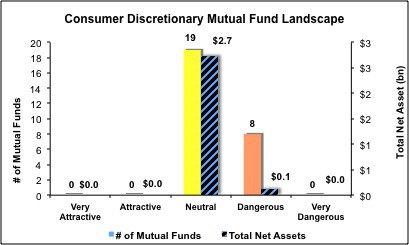
Review my full list of ratings and rankings along with reports on all 16 ETFs and 27 mutual funds in the Consumer Discretionary sector.
Sam McBride contributed to this report.
Disclosure: David Trainer owns COH. David Trainer and Sam McBride receive no compensation to write about any specific stock, sector or theme.

